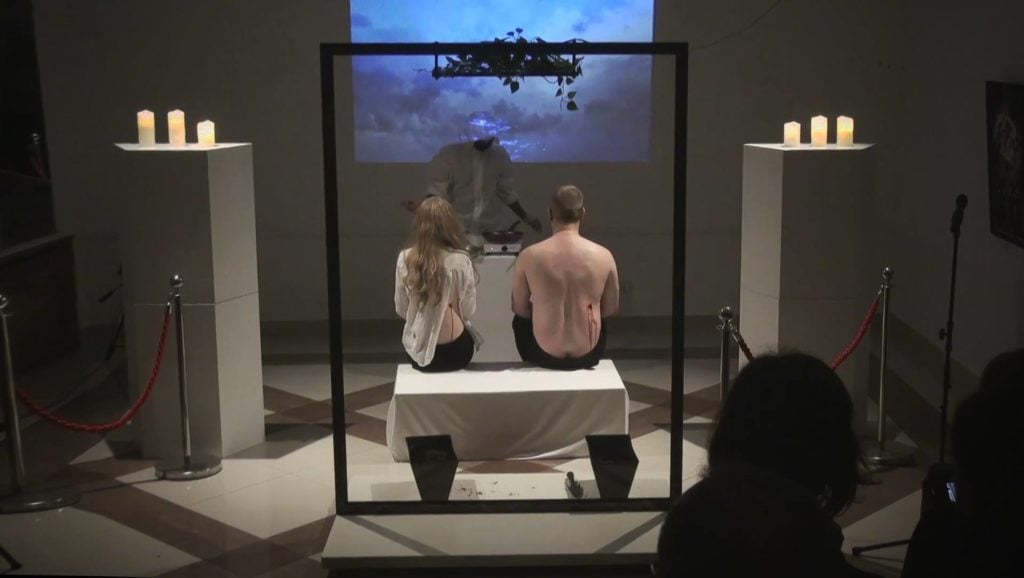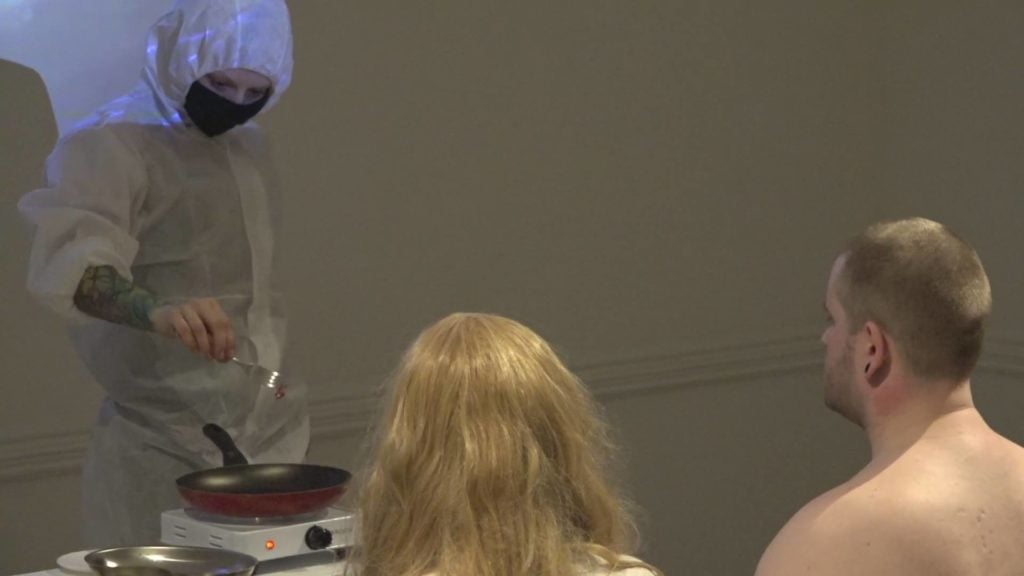Art World
Latvian Artist Is Accused of Promoting Cannibalism After Facebook Live Stream of Controversial Performance
See Arthur Berzinsh's controversial and close to the bone performance here.

See Arthur Berzinsh's controversial and close to the bone performance here.

Naomi Rea

The Latvian artist Arthur Berzinsh has provoked an online backlash after live-streaming a “cannibal” performance piece, during which two performers have their own flesh sliced off, fried, and fed to them.
The piece, titled Eschatology, and performed by Olga Kuļikova, Jānis Mihejevs, Suura Nettle, and the collective PainProTest, was staged earlier this month at the Grata JJ cultural center in Latvia’s capital city, Riga. In it, a woman in a white hazmat suit uses surgical tweezers and a scalpel to slice small sections of flesh from the backs of a male and female performer before frying the skin and feeding it back to them.
The piece has received many complaints online, with some commenters on Youtube calling it a bid to have cannibalism accepted by the mainstream, and the Sun Online reporting that the police were called on the artist.
Speaking to artnet News, Berzinsh denies the charge of “cannibalism,” saying “the amount of disinformation roaming on the internet now is extra difficult,” and calling the online mob “crazy conspiracy theorists.” He also said there was no police involvement; “there was no violence, nobody was forced to do anything against his/her will.”
Art cannot always be beautiful and comfortable, he says. “This performance has a very clear metaphor – even too clear for neo-conceptual art, and if you wish to comprehend the idea, it is up to you. And if you avoid the comprehension, you will see everything literally.” And regarding cannibalism: “Maybe fingernail gnawing or snot devouring also can be considered as a crime?”

Performers in Arthur Berzinsh’s Eschatology (2018). Photo courtesy @galerijamuseumlv via Facebook.
According to Berzinsh, the performance is a metaphor for consumer society consuming itself. The burying of children’s toys at the beginning of the ritual by the two performers is meant to show them stepping back from a condition of “supreme creativity” and “entering into the territory of what existential philosophy calls ‘das Man,’” explains Berzinsh in a comment he made to the video on Youtube.
The notion of das Man (loosely translated as the anonymous ‘One’) comes from Martin Heidegger’s Being and Time, and refers to someone who, rather than truly being in the world, lives an inauthentic life characterized by conformity.
The artist-philosopher explains that consumerism is the religion of our times; in modern society we have yet to discover greater meaning in our lives, so we fill ourselves by endlessly “consuming, products, resources, and each other,” albeit mentally rather than physically.
“I believe that the only true well-being is possible through self-realization, but [for this to be possible] we need the ontological destination. As long as we don’t have it, this self-realization is possible just for true individualists, [which] doesn’t mean much for the spirit of the whole civilization,” he writes. “And civilization can’t last for a long time without its spirit. So it just exterminates itself through putting this consumer program in us. This extermination starts metaphysically (in culture), and afterwards everything tumbles down to reality.”
Watch the controversial performance below. Warning: May Induce Nausea.